2017 Ducati Monster 797 Review: First Ride
Greener but in no way meaner, the air-cooled Desmodue Monster is still around for very good reasons
Hemlines and exhausts go up and down, radiators come and go, but the Monster hasn’t really ever gone out of fashion since it hit the runway, dang, has it really been 23 years ago? 1994 brought us Miguel Galluzzi’s original naked bike, and there’s been a veritable plethora of Monsters over the years ever since. Also Monsterinos, as Ducati likes to call the smaller-displacement ones.
2017 Ducati Monster 797
| Engine | 18.0/20 |
| Suspension/Handling | 13.0/15 |
| Transmission/Clutch | 8.75/10 |
| Brakes | 9.0/10 |
| Instruments/Controls | 4.5/5 |
| Ergonomics/Comfort | 9.0/10 |
| Appearance/Quality | 9.25/10 |
| Desirability | 9.0/10 |
| Value | 8.5/10 |
| Overall Score | 89/100 |
2017 Ducati Monster 797 Preview
The new 797 really does pay its respects to the original, right down to the very nice aluminum clasp that holds down the front of its 4.4-gallon steel fuel tank. The steel trellis frame is an important design element; the red frame and alloy cooling fins are now a classic combination (or you can go dark and get a black bike with black frame), complete with passenger grab rails which provide a good place for bungee hooks. The single not-quite round headlight incorporates a couple of LED marker lights, which you’ll find in the tail and turnsignal lights too.
There’s a handy timeline right here, which refreshes our memory of the last air-cooled Monster – the 796 of 2010. Ducati says the new 797 is all-new, from stem to stern, sharing only its steel gas tank and headlight with the Monster 1200. (And they’d really rather not mention that its 803cc 90-degree V-Twin is just like the one in the Scramblers, except for engine mapping. And hey, wait a minute! The Monster 796 was also powered by an 88 x 66mm 803cc L-Twin.)
Anyway, the claim is 75 horsepower, and in fact that engine made 69.6 rear-wheel Dynojet ponies at 8500 rpm when we flogged it in our 2015 Scrambler Slam, and 46.5 pound-feet of torque at 7000 rpm: 75 is actually 12 hp less than Ducati claimed for the 796, but it does come 500 rpm sooner in the 797, and the new bike is of course Euro-4 compliant. In any case, why question?
In its unadorned 803cc form, it becomes even more obvious what a great gift Dr. Taglioni bequeathed us in the perfectly balanced 90-degree desmodromic Twin, simply because you wind up revving the smaller version out much more often. Ducati says it’s making 80% of maximum torque at just 3500 rpm, and you really don’t need to spin it that hard all the time. But it’s a lot of fun when you do, and the engine’s happy to hit its 9000 rpm high note as often as you feel the need.
The compactness of the whole package encourages you to let loose, too. Ducati wanted the 797 to be super approachable and unintimidating –“undemanding fun”– much like Triumph’s goal for its new Street Twin, and that’s just how the thing plays out: Its rider triangle is a bit more upright and comfortable than the 796, the seat’s surprisingly cush and low enough at 31.7 inches. Controls and levers really do fall readily to hand and foot in the most cliche way and operate easily, and the nice handlebar and plenty of steering lock make tight maneuvering graceful and confident.
That all-new trellis frame mates to an aluminum swingarm controlled by a cantilevered Sachs shock wrapped in a progressive spring, and the first inch or so of its 150mm of travel is nicely supple, just like the 43mm Kayaba inverted fork and its 130mm of travel. The shock offers up rebound and spring preload adjustments. For my 160 pounds, it seemed right in the ballpark as delivered – just firm enough without ever being punishing.
While they were at making the thing Euro-4 compliant, they added a pair of fuel injectors beneath the 50mm throttle butterfly, a thing Ducati says provides really smooth power delivery and better control of the fuel mixture. It works; this one comes into the power really smoothly when you roll it on and makes nice, linear thrust right up to the rev limiter, and enough of it to leave your Triumph Street Twin in the dust. I did squeeze in one quick street blast before the rain came down, and the Monster is a bike you can make rapid progress upon in the curves, quick to dive into corners either on the gas or the brakes or both at once, with full-size Pirelli Diablo Rosso II tires providing plenty of grip at both ends. All systems nice and taut.
Nobody wanted it to rain there on the Cote d’Azur, but it provided a great test bed for the 797 when it did; its supple suspension and sweet power delivery provide a good rain set-up; those things and the bike’s natural ergonomics made it a lot of fun to try to keep up with the rain-suited Ducati test rider on a loop through the mountains. Careful over those wet tar strips, and the Monster is a hoot to ride in the rain, quick and light steering but not too. Easy on the lean angle, stay off the manhole covers, get it pointed in the right direction, and time to roll on the gas again for another L-Twin burst of pleasure. The Pirellis seem to have plenty of grip in the wet too.
The front brakes’ sintered pads almost have too much initial bite, but that’s an easy enough thing to adjust to; the rear has plenty of feel for adjusting your speed through all those stone-wall-lined sharp corners.
I think it was Stefano Tarabusi, Ducati’s product manager, who said “simplicity is the ultimate sophistication.” With this one, there’s no stinking traction control or any ride modes. Blip the throttle yourself when you want to downshift (the six-speed is typically Ducati excellent, the APTC slipper clutch pull is really light but you barely need it once rolling). You do get standard ABS, though, along with LED lights and an LCD instrument panel that’s Bluetooth ready. Also a USB port under the seat.
Aside from those modern amenities, this base model is the entry point into the Ducati line for those who may feel themselves for whatever reason not hip enough to ride a Scrambler, or who want a tad more sporting capability. What you see is what you get, a bare-bones minimalist naked bike just like the original.
Like every manufacturer worth Its salt these days, of course there are already quite a few options available: tank and tailbags, exhausts, a 25mm taller comfort seat and a 20mm-lower low-seat option. Not to mention all the truly nice riding gear ensembles the Ducati fashion people have picked out (most of it made in partnership with Dainese) to complement your dynamic Italian-American on the go lifestyle, a slightly different one than the bearded hipster caffeine fiend on the make the Scramblers seem to target.
Fashionable or not, it seems like the Monster might retain its crown when we throw it in against other likely contenders in the middleweight naked bike category, even if at $9,295 it’s a bit pricier than a few of them. If you’ve got the extra dough over a Triumph Street Twin, the Monster does offer quite a bit more power and higher-spec componentry. Those of questionable taste might consider an SV650 Suzuki comparable. The Yamaha FZ-07 is a worthy combatant and way less spendy… sadly, the new H-D Street Rod probably isn’t, but that’s a question yet to be decided by the whole MO crew.
When we do get around to comparing them, you can bet it will be one of the most fun group rides we’ll do, simply because this class of bike is all about pure motorcycling enjoyment with less of the high testosterone sphincter-clenching drama of faster, more expensive and more complicated rigs. This Monster 797 embodies the idea that less is more in spades – pure and simple, light and wonderfully easy to just swing a leg over and go for a ride.
2017 Ducati Monster 797
+ Highs
- Simple, air-cooled two-valve Desmo
- Nimble, comfortable, a daily driver Ducati
- Seamless, Honda-like functionality
– Sighs
- 7500-mile valve clearance checks
- Is this Monster too domesticated?
- Yes 1994 really was 23 years ago.
| 2017 Ducati Monster 797 Specifications | |
|---|---|
| MSRP | $9,295 |
| Engine Type | L-Twin, 2 Desmodromically actuated valves per cylinder, Air cooled |
| Displacement | 803cc (49 cu in) |
| Bore x Stroke | 88 x 66mm (3.46 x 2.60 in.) |
| Compression Ratio | 11.0:1 |
| Power | 75 hp (55 kW) at 8250 rpm (claimed) |
| Torque | 50.8 lb-ft at 5750 rpm (claimed) |
| Fuel Injection | Electronic fuel injection system, Ø 50 throttle bodies |
| Exhaust | 2-1 system with catalytic converter and two lambda probes, Single stainless steel muffler with aluminum cover |
| Transmission | 6 speed |
| Primary Drive | Straight cut gears, Ratio 1.85:1 |
| Gear Ratios | 1=32/13 2=30/18 3=28/21 4=26/23 5=22/22 6=24/26 |
| Final Drive | Chain drive, Front sprocket Z15, Rear sprocket Z46 |
| Clutch | APTC wet multiplate clutch with mechanical control |
| Chassis | |
| Frame | Tubular steel trellis frame |
| Front Suspension | Ø 43 Kayaba usd fork, 5.12 in. travel |
| Rear Suspension | Sachs monoshock, Preload and rebound adjustable, 5.91 in. travel |
| Front Wheel | 10-spoke light alloy, 3.50” x 17” |
| Rear Wheel | 10-spoke light alloy, 5.50” x 17” |
| Front Tire | Pirelli Diablo Rosso II, 120/70 ZR17 |
| Rear Tire | Pirelli Diablo Rosso II, 180/55 ZR17 |
| Front Brake | 2 x Ø 320mm semi-floating discs, radially mounted monoblock Brembo M4.32 callipers, 4-piston, axial pump with Bosch ABS as standard equipment |
| Rear Brake | Ø 245mm disc, 1-piston calliper with Bosch ABS as standard equipment |
| Instrumentation | LCD display |
| Dry Weight | 386 lb (claimed) |
| Kerb Weight | 425 lb (claimed) |
| Wet weight (without fuel) | 401 lb (claimed) |
| Seat Height | 31.69 in. |
| Wheelbase | 56.50 in. |
| Rake | 24° |
| Trail | 3.54 in. |
| Fuel Tank Capacity | 4.36 US gal |
| Standard Equipment | Bosch ABS, LED position light and tail light, USB power socket, DMS ready |
| Colors | White, Red, Black |
| Warranty | 24 months |
| Maintenance service interval | 12000 km (7500 mi) / 12 months |
| Valve clearance check | 12000 km (7500 mi) |
| Emissions Standard | Euro 4 |
| CO2 emissions | 119 g/km |
| Consumption | 44.38 mpg (claimed) |
More by John Burns



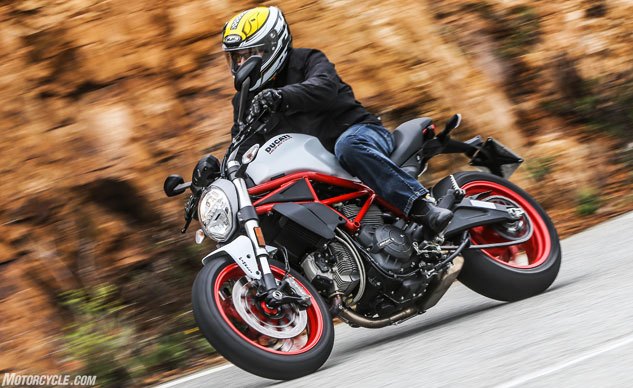
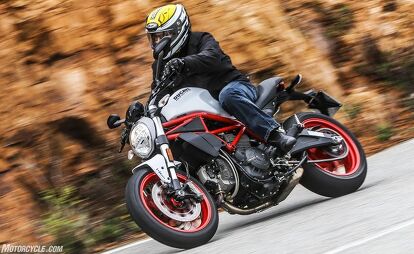

















































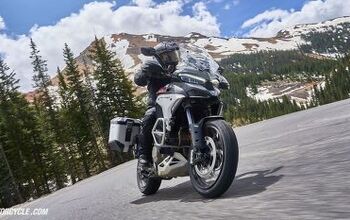
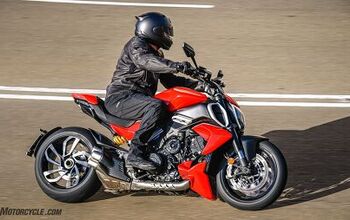








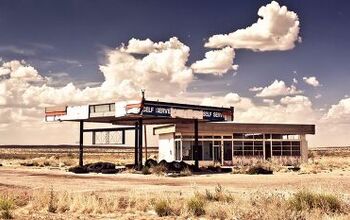




Comments
Join the conversation
What is 'bluetooth ready'?? Genuinely curious. Nice model i guess, still not sure who would go for this over the 821. Its more modern in every way, and without the price shock of those 7500mile valve intervals that never get mentioned until you're out the door with your new scrambler or monster 797. The 821 is completely tame and friendly, maybe not as a first bike, but who the heck would buy a brand new Ducati as a first bike in the first place?
But is a new Ducati 797 worth $1800 more than the (2019) Suzuki SV650 ABS now that the SV has 4 piston front brakes, and retains better instrumentation and reliability? Both L-twins put out similar power/torque: seems like the critical difference is in the handling in the twisties, especially when the road gets rough. Can anyone comment on how these two compare there?
PS How does the Ducati get a 4.5/5.0 on "instrumentation/controls" when it does not have a fuel gauge or gear position indicator, especially when the SV650, which has all of this and more, only gets a 4.0/5.0? Also the comment in the review about "plenty of steering lock" conflicts with what other reviews and owners say - the steering lock is surprisingly limited and makes the bike questionable for new riders. Finally, I'm reading that the transmission is surprisingly notchy for the first 1000 km, and neutral is almost impossible to find.